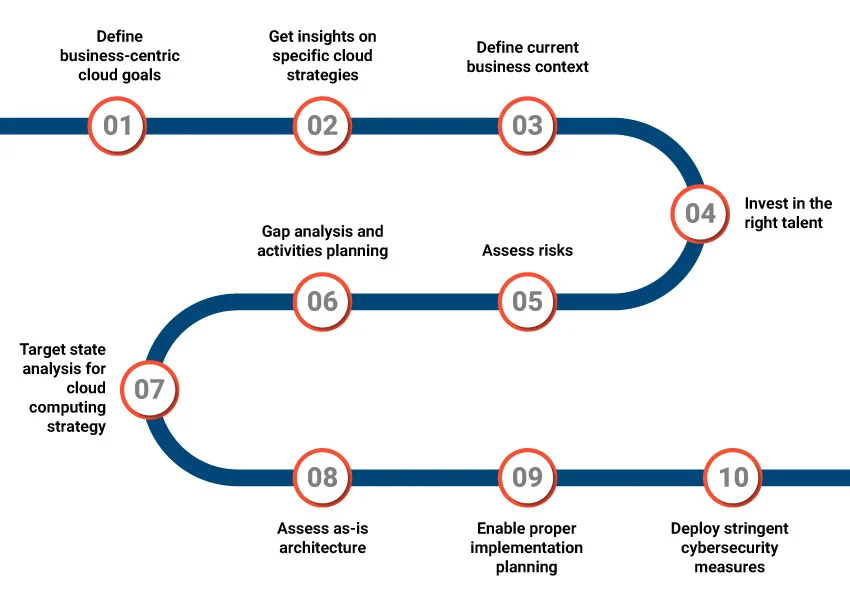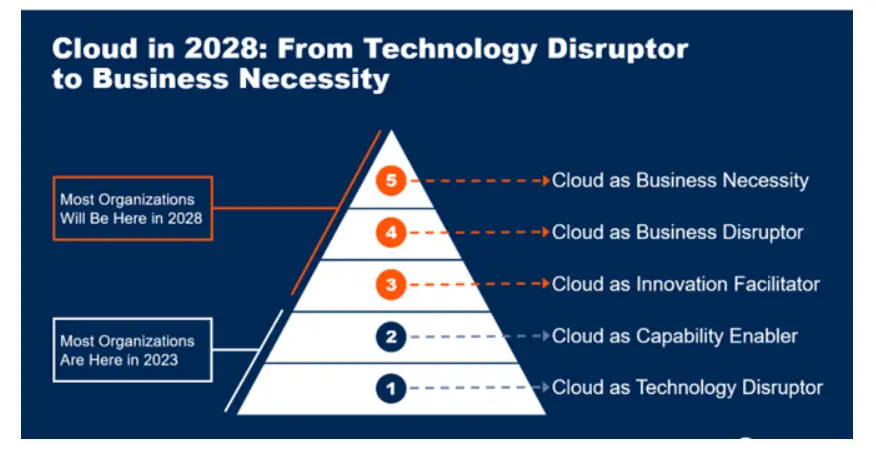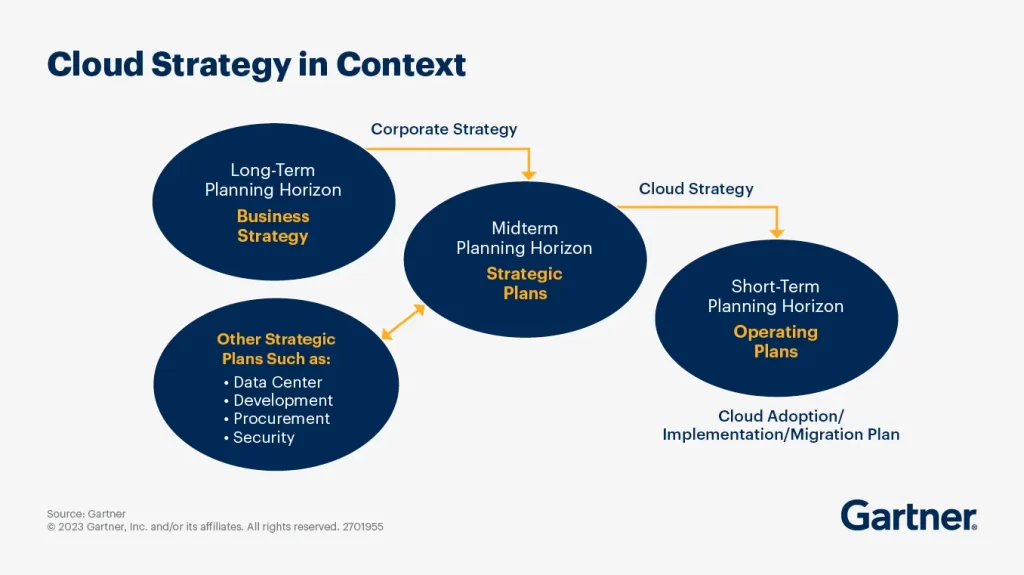April 26, 2024 - by Synoptek
In today’s rapidly evolving business landscape, a well-planned and skillfully implemented cloud strategy is no longer a luxury. Gartner predicts that by 2028, cloud computing will become a business necessity. Over 50% of enterprises will use industry cloud platforms to accelerate business initiatives.
Organizations need cloud managed services to benefit from expert IT management of their cloud platforms and applications, allowing them to focus on strategic activities. These services help businesses manage, maintain, and optimize their cloud infrastructure and operations, especially when they lack in-house expertise or resources.
With the rise of enterprises integrating cloud managed services, the importance of a robust plan rises, too.
Therefore, diligently focusing on the “what” and “why” before embracing the new technology is vital. Ensuring alignment of specific business objectives with important technological decisions can contribute actively to organizational goals. Organizations of all sizes must balance innovation, agility, and scalability in their cloud technology strategy. They must avoid distractions that could significantly dilute focus, time, effort, costs, and resources.
Whether you are a business owner, a CTO, or the founder of a startup, this blog provides insights on how you can develop robust cloud infrastructure to reach sky-high success.
Source: Gartner
Different Types of Cloud Strategies
Cloud strategy is a crucial aspect of modern business, enabling organizations to leverage the benefits of cloud computing effectively. There are four main types of cloud strategies:
Public Cloud
A single public cloud strategy involves utilizing services from a single cloud provider such as AWS, Google Cloud, or Microsoft Azure. It offers scalability, cost-effectiveness, and ease of management but may limit customization options. It is ideal for organizations looking for straightforward cloud solutions without the complexity of managing multiple providers.
Private Cloud
A single private cloud strategy operates within a dedicated infrastructure, offering enhanced security and control. It is suitable for organizations with sensitive data or stringent compliance requirements. Requires a higher initial investment but provides tailored solutions to meet specific business needs.
Hybrid Cloud
A hybrid cloud strategy combines elements of public and private clouds to optimize data management and workload distribution. It enables flexibility in deploying workloads based on specific requirements. It also enhances scalability and efficiency while allowing organizations to maintain control over critical data.
Multi-Cloud
Multi-cloud strategy involves using services from multiple cloud providers simultaneously to leverage the strengths of each platform. It reduces vendor lock-in risks, enhances redundancy, and promotes cost optimization.
Whatever cloud strategy you choose will require robust management practices for seamless integration, security, and performance across diverse cloud environments.
Challenges in Crafting a Perfect Cloud Strategy
Crafting a perfect cloud strategy involves overcoming various challenges that organizations commonly encounter. These challenges include:
- IT Staffing and Talent Scarcity: Finding skilled professionals to manage and optimize cloud environments is challenging.
- Network Infrastructure: Ensuring robust and reliable network connectivity to support cloud services effectively.
- Security Concerns: Addressing cybersecurity issues and ensuring data protection in the cloud environment.
- Legacy IT Systems: Integrating and modernizing legacy systems with constantly evolving cloud technologies.
- Cultural and Process Changes: Managing organizational change and adapting workflows to align with cloud practices.
- Cost Management: Balancing the costs associated with cloud services, including migration, maintenance, and optimization.
- Compliance and Regulatory Requirements: Ensuring adherence to data protection laws, industry regulations, and compliance standards in the cloud environment.
- Employee Experience: Focusing on user adoption, training, and support to enhance employee satisfaction and productivity during the cloud transition.
The Benefits of Implementing a Future-proof Cloud Strategy
A future-proof cloud strategy is a comprehensive approach that anticipates and adapts to evolving needs and technologies. It involves designing cloud infrastructure and services with resilience in mind to ensure long-term relevance and effectiveness.
By incorporating elements like advanced security measures, robust governance, and agility, a future-proof cloud strategy sustainably supports an organization’s growth in the volatile digital landscape.
Implementing a future-proof cloud strategy and engaging with a cloud-managed services provider offers several benefits that ensure the longevity and adaptability of the cloud infrastructure:
- Scalability and Flexibility: A future-proof cloud strategy allows for seamless scalability and flexibility, enabling businesses to easily adjust resources and services as needed to meet evolving demands without the need for significant reconfiguration.
- Adaptability to Emerging Technologies: Organizations can easily adapt to emerging technologies and trends, ensuring that their cloud infrastructure remains relevant and capable of integrating new innovations without major disruptions.
- Enhanced Security Measures: A resilient cloud strategy includes prioritizing robust security measures that can adapt to evolving threats and compliance requirements, safeguarding data, and applications effectively.
- Cost Efficiency: Such cloud-strategies focus on optimizing costs by ensuring efficient resource allocation, minimizing waste, and leveraging the most cost-effective cloud services and solutions over time.
- Continuous Improvement: Helps to build a culture of continuous optimization, where regular monitoring, evaluation, and adaptation. It also ensures that the cloud infrastructure remains aligned with business goals, drives innovation, and delivers maximum value consistently.
Future-proofing your cloud strategy is crucial for building a resilient and adaptable cloud that empowers your business to thrive in today’s digital landscape.
Source: Gartner
10 Steps to Get Started with a Cloud Strategy Roadmap
A well-defined cloud strategy roadmap serves as a guiding framework that outlines the path towards successful cloud adoption. By following a structured approach and implementing key steps, organizations can effectively navigate the complexities of cloud migration. Also, it helps to align IT initiatives with business objectives and lay the foundation for a scalable, secure, and future-ready cloud infrastructure.
To embark on a successful cloud strategy roadmap, consider the following ten essential steps:

- Define Business-Centric Cloud Goals: Align cloud initiatives with overarching business objectives to ensure strategic relevance and value.
- Get Insights on Specific Cloud Strategies: Research and understand various cloud strategies (e.g., public, private, hybrid) to determine the most suitable approach for your organization.
- Define Current Business Context: Evaluate existing IT infrastructure, applications, and processes to identify areas where cloud adoption can drive improvements.
- Invest in the Right Talent: Build a skilled cloud team or partner with experts to effectively support the implementation and management of cloud solutions.
- Assess As-is Architecture: Evaluate your current IT architecture to identify dependencies, constraints, and areas that can benefit from cloud migration.
- Conduct a Target State Analysis for Cloud Computing Strategy: Define the desired future state of your IT environment post-cloud adoption to guide decision-making and planning.
- Carry out a Gap Analysis: Identify gaps between current and target states, prioritize activities, and develop a roadmap for cloud implementation.
- Evaluate Risks: Conduct a thorough risk assessment to identify potential challenges and develop mitigation strategies to ensure a smooth transition to the cloud.
- Enable Proper Implementation Planning: Develop a detailed implementation plan outlining timelines, resource allocation, milestones, and key performance indicators for tracking progress.
- Deploy Stringent Cybersecurity Measures: Prioritize security by implementing robust measures to protect data, applications, and infrastructure in the cloud environment.
By following these steps diligently, C-Suite can lay a solid foundation for a successful cloud strategy roadmap that aligns with business goals and drives digital transformation effectively. Collaborating with a cloud partner can streamline operations, enhance efficiency, and leverage specialized expertise to navigate the complexities of cloud adoption effectively.
A Quick Recap
The driving principle behind future-proofing your cloud strategy is managing change rather than avoiding or preventing it. Involving stakeholders from various departments in developing cloud strategy will foster collaboration, ensure alignment with business goals, and enhance organizational buy-in.
Setting clear baselines for performance, security, and cost metrics will allow you to measure the success of the cloud strategy implementation and track improvements over time. Conducting a thorough assessment of your current IT infrastructure, applications, and processes is essential to identify gaps, dependencies, and opportunities for improvement.
Learning from common pitfalls such as underestimating migration complexity, neglecting security considerations, or failing to optimize costs can help organizations avoid costly setbacks.
By incorporating these critical takeaways into the cloud strategy, organizations can enhance effectiveness, optimize performance, ensure security and compliance, and drive business value.
If you’re looking to develop a strategic roadmap to ensure a smooth and successful transition to the cloud, here’s how Synoptek cloud experts can help.




